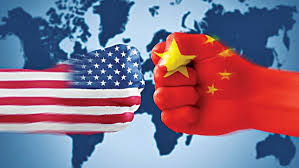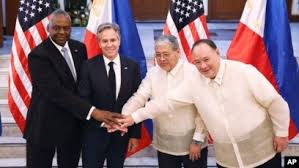In a move that can be likened to a decisive opening gambit in a high-stakes chess game, the United States announced it will be giving the Philippines a hefty US$500 million to boost its military capabilities. This financial boost comes as Manila continues to face off against an increasingly assertive Beijing in the disputed South China Sea.
US Secretary of State Antony Blinken and Defence Secretary Lloyd Austin delivered the news after meeting with Philippine President Ferdinand Marcos Jr, along with their Filipino counterparts, Foreign Secretary Enrique Manalo and Defence Secretary Gilberto Teodoro Jr. Mr Austin described the funding as a “once-in-a-generation investment” aimed at modernising the Philippines’ armed forces and coast guard.
“This level of funding is unprecedented and sends a clear message of support for the Philippines from the Biden-Harris administration, US Congress, and the American people,” Austin said during a joint press briefing.
More than a Fistful of Dollars!
To put things into perspective, Manila received about US$1.14 billion in US military assistance from 2015 to 2022, including US$475.3 million in foreign military financing. This latest funding boost is part of a broader US strategy to strengthen alliances in the Indo-Pacific region as it competes with China for influence.
The American officials are in the midst of a 10-day tour of the Indo-Pacific, which started in Tokyo and includes stops in Vietnam, Laos, and Singapore. In addition to the $500 million, President Biden is proposing a separate US$128 million fund for infrastructure projects at the nine Philippine military bases that the US can access under the Enhanced Defence Cooperation Agreement (EDCA).
More US Bases on Philippines soil
Signed in 2014, the EDCA allows American forces to build facilities, bring in equipment, and conduct joint training exercises at agreed-upon bases in the Philippines. While it permits the rotation of US troops for extended stays, it does not establish a permanent US presence in the country. In 2023, President Marcos expanded the scope of the EDCA, increasing the number of bases the US can use from five to nine.
President Marcos expressed his satisfaction with the ongoing collaboration, noting the importance of maintaining open lines of communication. “I’m always very happy that these communication lines are very open so that all the things that we are doing together, in terms of our alliance, in terms of the specific context of our situation here in the West Philippine Sea and in the Indo-Pacific, are continuously examined and re-examined so we are agile in terms of our responses,” he said.
The West Philippine Sea, as the Philippines calls the eastern part of the South China Sea within its exclusive economic zone, also falls within China’s expansive nine-dash line claim. Defence Secretary Teodoro emphasised that the new funding would enhance the Philippines’ ability to deter unlawful aggression, particularly from China.
“Every peso or dollar spent on hardening Philippine capabilities to defend itself and deter unlawful aggression will be a plus against any threat actor, whether it be China or anyone else,” Teodoro added.
Threat of the China Dragon?
The US’s support for the Philippines comes shortly after a tense incident between Chinese and Philippine naval forces at the Second Thomas Shoal, highlighting the volatile nature of the region. Although China and the Philippines have since reached a provisional arrangement regarding the area, the specifics remain undisclosed.
Blinken underscored the shared concerns about China’s escalatory actions in the region. “Both of us (the US and the Philippines) share concerns, and many other countries in the region share concerns as well, about some of the actions that the People’s Republic of China has taken – escalatory actions in the South China Sea, East China Sea, and elsewhere,” he said.
The US reaffirms its commitment to the 1951 Mutual Defence Treaty, which obligates both nations to support each other in the event of an armed attack. This includes attacks on Filipino military and coast guard forces, vessels, and aircraft in the Pacific, including the South China Sea.
The Philippines and the United States are bound by their long-standing 1951 Mutual Defence Treaty (MDT), which calls on both sides to help each other in times of aggression by an external power.
At Tuesday’s press briefing, Blinken reiterated Washington’s commitment to upholding the treaty and made clear that it covered a wide range of scenarios related to Manila’s current conflict with Beijing.
“We stand by our ironclad defence alliance with the Philippines under the MDT. That extends to armed attacks on the AFP (Armed Forces of the Philippines), public vessels or aircraft, including the coastguard, anywhere in the Pacific, including the South China Sea,” Blinken said.
Marcos Junior is Bullish
Before meeting with their counterparts, the two US officials met with President Ferdinand Marcos Jr, who has taken a much more confrontational approach toward his country’s territorial disputes with China and significantly increased security ties with Washington since coming to power two years ago.
Blinken told Marcos this year’s ministerial dialogue were “historic” since it is the first time that the Philippines is hosting them.
“It’s, I think, really evidence of a steady drumbeat of very high-level engagements between our countries that are covering the full range of issues and opportunities that bring us together, not only security, but also economic, and we’re truly grateful for this partnership,” he added.
However, some analysts suggest that the US may be encouraging Manila to de-escalate tensions with China due to its involvement in other global military crises. Political analyst Robin Garcia of WR Advisory Group highlighted the importance of US support in strengthening the Philippines’ resolve against China’s aggression.
Security circle
Beyond military aid, the development of EDCA sites is seen as a significant incentive for the Philippines. Edcel Ibarra, a political analyst from the University of the Philippines, noted, “One of the selling points of EDCA has always been that the Philippines is going to own whatever was built on the EDCA sites, and it’s a very important signal that both parties are now very serious in implementing EDCA as originally intended.”
Blinken and Austin’s visit to Manila is part of an 11-day trip to Asia, with other stops on the itinerary including Japan, Singapore and Vietnam – all countries that have increased security ties with the Philippines in recent months.
Meanwhile, Blinken’s tour continues with a stop in Singapore, where he will engage in high-level meetings and co-chair the US-Singapore Critical and Emerging Technology Dialogue, further solidifying the US’s commitment to the region.
In this strategic chess game, every move counts, and the US’s latest funding to the Philippines is a clear message to Beijing that Washington is fully committed to backing its allies in the Indo-Pacific. The next moves on this geopolitical chessboard will be watched closely by the world.




Interesting read. Gives a lot of food for thought. China vs India also.